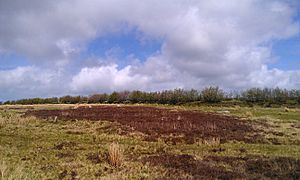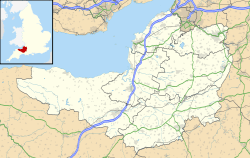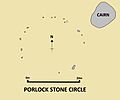Porlock Stone Circle facts for kids

The location of the circle in 2014; the stones are so small that discerning the site is difficult
|
|
| Location | Porlock |
|---|---|
| Coordinates | 51°11′22″N 3°39′14″W / 51.189549°N 3.653994°W |
| Type | Stone circle |
| History | |
| Periods | Neolithic / Bronze Age |
Porlock Stone Circle is an ancient ring of stones located on Exmoor, a beautiful area near the village of Porlock in Somerset, England. This stone circle is part of a long tradition of building similar monuments across Britain, Ireland, and France. People built these circles during the Late Neolithic and Early Bronze Age periods, which was between 3300 and 900 BCE.
We don't know exactly why these stone circles were built. However, archaeologists think that the stones might have represented special spirits or gods for the people who created them. The Porlock circle is about 24 meters (79 feet) wide and has thirteen green sandstone rocks. There might have been more stones originally.
Even though many ancient monuments were built on Exmoor during the Bronze Age, only two stone circles remain today. The other one is the Withypool Stone Circle. A small lead wheel found at Porlock suggests that people visited the site even during the Roman times. The circle was rediscovered in the 1920s and has been studied by archaeologists like Harold St George Gray and Mark Gillings.
Contents
Where is Porlock Stone Circle Located?
The Porlock Stone Circle is found about 4.4 kilometers (2.75 miles) southwest of the village of Porlock. It's in the southwest of England, in the county of Somerset. The circle sits high up, almost 415 meters (1,362 feet) above sea level. It is also about 10 kilometers (6.2 miles) north of the Withypool Stone Circle.
The land around the circle gently slopes downwards from the northeast to the southwest. From the circle, you can see many other ancient burial mounds, called round barrows or tumuli, from the Bronze Age. Some of these nearby mounds include Alderman's Barrow, Black Barrow, and the Kit Barrows. To the east-northeast of the circle, there's an old fort called Berry Castle. This fort was built much later, during the Late Iron Age or Roman period.
Why Were Stone Circles Built?
Around 3000 BCE, people in Britain started building different kinds of monuments. Instead of the long mounds and large enclosures they used to build, they began creating circular structures. These included earthen henges, wooden circles, and stone circles. Stone circles are found in most parts of Britain where there are natural stones. They are especially common in southwest England and northeast Scotland.
The building of these stone circles might have continued for a very long time, from 3300 to 900 BCE. The main period of construction was between 3000 and 1300 BCE. After they were built, these stone circles often show very few signs of people visiting them regularly. This suggests they might have been quiet, empty places, not used for everyday rituals.
Some archaeologists think that in ancient Britain, stone was linked to the dead, while wood was linked to the living. Others believe the stones might have represented not ancestors, but other powerful beings, like gods.
Stone Circles on Exmoor
On Exmoor, there are only two known prehistoric stone circles: Porlock and Withypool Stone Circle. Another circular stone monument on Almsworthy Common was once thought to be a circle, but now experts believe it's a different type of ancient stone setting.
Archaeologists believe these circles on Exmoor were built in the Late Neolithic or Early Bronze Age. They are similar to the stone circles found further south on Dartmoor. However, Dartmoor has over seventy such monuments, while Exmoor has only two. This difference might be because Exmoor doesn't have natural granite, which is a very hard stone. Instead, it has softer rocks that break into smaller pieces. This means there weren't many large stones available on Exmoor.
Because large stones were rare, ancient communities on Exmoor used smaller stones, sometimes called miniliths, for their circles and other monuments. However, there are some places on Exmoor, like the clapper bridge at Tarr Steps, that do use very large local stones. This suggests that if the builders wanted bigger stones, they could have found them. So, using smaller stones might have been a deliberate choice.
Exmoor also has other ancient monuments from the Bronze Age. These include hundreds of round burial mounds, standing stones, and linear stone rows. The fact that people built so many different types of monuments might also explain why there are so few stone circles here.
What Does Porlock Stone Circle Look Like?
Porlock Stone Circle is about 24 meters (79 feet) across. The stones are made of green sandstone from the Devonian period, and they were likely gathered from the local area. Archaeologist Mark Gillings found that three types of stones were used: small upright stones, low upright stones, and larger stones placed in a sloping position. Many of the sloping stones were thin and chosen or shaped to be tapered.
Gillings noticed that some stones were mostly buried underground, with only a small part sticking out. He suggested this might have been a "deliberate inversion of the upright stone ideal." This idea of "inversion" is also seen at other ancient sites. It might mean that the circle had a strong connection to the underworld or earth.
Changes Over Time
When the site was first studied in the 1920s, there were ten upright stones and eleven lying down. Experts thought there might have originally been about forty-three stones in the circle, spaced about 2 meters (6.6 feet) apart. The biggest gaps in the circle were where stones might have been taken away to build roads.
In 1950, it was noted that some stones had been moved during military training in the Second World War. By 1989, only thirteen stones remained, and some were in different spots than before. A survey in 2009 found only ten stones. However, a more detailed study in 2013 revealed eleven upright stones and eight fallen ones. Today, the circle is a mix of ancient stones and newer ones that have been added over time.
Nearby Ancient Structures
Right next to the northeast side of the circle is a cairn, which is a mound of stones. Many of its stones have been removed over the years. About 57 meters (187 feet) to the southeast of the circle, there is a line of small stones. This stone row was first noticed in 1975 and had eight stones, six of them standing upright, covering a length of 12 meters (39 feet). The stones were very small and hard to see in the grass.
In 2012, a controlled burn of the heather showed five more stones at the end of the row, making it much longer, about 35.23 meters (115.6 feet). We don't know for sure how this stone row is connected to the circle. This is because roads and quarries have been built in the area between them.
Archaeologist Mark Gillings thinks that the stone row and cairn were part of a larger ancient landscape that included Porlock Stone Circle. He believes the cairn was built in the Early Bronze Age, and the stone circle might have been added later, in the Middle Bronze Age, as part of a bigger plan for the area around the cairn.
Was Porlock Stone Circle Used by Romans?
During the 2013 excavation, archaeologists found a small lead wheel with four spokes buried in the circle. It was about 7 centimeters (2.8 inches) wide. While they couldn't be absolutely sure, it looked like ancient items from the Late Iron Age and early Roman times. These items are sometimes found in Britain and more often in France. If this is true, it means that people knew about and visited Porlock Stone Circle during the Roman period in Britain.
How Has the Circle Been Studied?
The Porlock Stone Circle was rediscovered in the early 1900s by E. T. MacDermot. He noticed the wider circle after the heather was burned away. MacDermot told archaeologist Harold St George Gray about his discovery. In 1928, Gray surveyed the circle and dug a small area in its center. He found some stone slabs but no charcoal.
In 2009, archaeologists Mark Gillings and Jeremy Taylor used a special survey method called resistivity to study the site. This method can detect things buried underground. Their survey suggested that there might have been rectangular structures around the circle at some point. However, they knew that digging would be needed to find out when these structures existed.
Gillings led an excavation in 2013. His team dug a trench around the northern part of the circle. They didn't find any artifacts from when the circle was first built. They also dug another trench to look at stones to the east of the circle, which they thought were part of the stone row.
Protecting the Ancient Site
Porlock Stone Circle is now a protected ancient monument under a special law. This means it's legally protected from being changed or damaged. Surveys have shown that the circle's condition has gotten worse over time. In 1950, 21 stones were identified as part of the circle, but by 2009, only 10 were found.
Interestingly, new stones have also been added to the circle in recent years. This creates a challenge for those who manage ancient sites: should these newer stones be removed, or should they be accepted as part of the circle's ongoing story?
Images for kids





